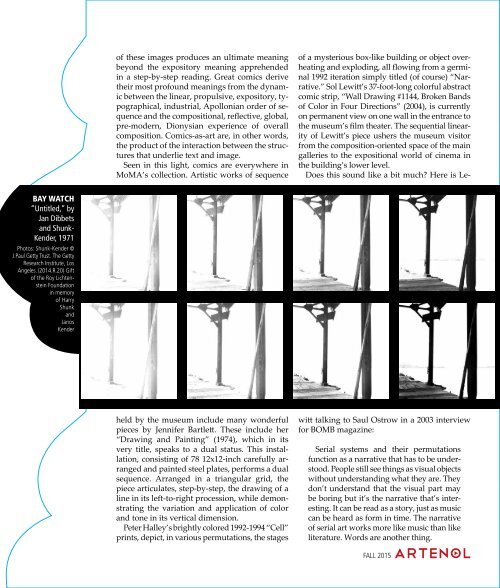Artenol_Fall_flipbook
You also want an ePaper? Increase the reach of your titles
YUMPU automatically turns print PDFs into web optimized ePapers that Google loves.
of these images produces an ultimate meaning<br />
beyond the expository meaning apprehended<br />
in a step-by-step reading. Great comics derive<br />
their most profound meanings from the dynamic<br />
between the linear, propulsive, expository, typographical,<br />
industrial, Apollonian order of sequence<br />
and the compositional, reflective, global,<br />
pre-modern, Dionysian experience of overall<br />
composition. Comics-as-art are, in other words,<br />
the product of the interaction between the structures<br />
that underlie text and image.<br />
Seen in this light, comics are everywhere in<br />
MoMA’s collection. Artistic works of sequence<br />
BAY WATCH<br />
“Untitled,” by<br />
Jan Dibbets<br />
and Shunk-<br />
Kender, 1971<br />
Photos: Shunk-Kender ©<br />
J.Paul Getty Trust. The Getty<br />
Research Institute, Los<br />
Angeles. (2014.R.20) Gift<br />
of the Roy Lichtenstein<br />
Foundation<br />
in memory<br />
of Harry<br />
Shunk<br />
and<br />
Janos<br />
Kender<br />
held by the museum include many wonderful<br />
pieces by Jennifer Bartlett. These include her<br />
“Drawing and Painting” (1974), which in its<br />
very title, speaks to a dual status. This installation,<br />
consisting of 78 12x12-inch carefully arranged<br />
and painted steel plates, performs a dual<br />
sequence. Arranged in a triangular grid, the<br />
piece articulates, step-by-step, the drawing of a<br />
line in its left-to-right procession, while demonstrating<br />
the variation and application of color<br />
and tone in its vertical dimension.<br />
Peter Halley’s brightly colored 1992-1994 “Cell”<br />
prints, depict, in various permutations, the stages<br />
of a mysterious box-like building or object overheating<br />
and exploding, all flowing from a germinal<br />
1992 iteration simply titled (of course) “Narrative.”<br />
Sol Lewitt’s 37-foot-long colorful abstract<br />
comic strip, “Wall Drawing #1144, Broken Bands<br />
of Color in Four Directions” (2004), is currently<br />
on permanent view on one wall in the entrance to<br />
the museum’s film theater. The sequential linearity<br />
of Lewitt’s piece ushers the museum visitor<br />
from the composition-oriented space of the main<br />
galleries to the expositional world of cinema in<br />
the building’s lower level.<br />
Does this sound like a bit much? Here is Lewitt<br />
talking to Saul Ostrow in a 2003 interview<br />
for BOMB magazine:<br />
Serial systems and their permutations<br />
function as a narrative that has to be understood.<br />
People still see things as visual objects<br />
without understanding what they are. They<br />
don’t understand that the visual part may<br />
be boring but it’s the narrative that’s interesting.<br />
It can be read as a story, just as music<br />
can be heard as form in time. The narrative<br />
of serial art works more like music than like<br />
literature. Words are another thing.<br />
FALL 2015

















